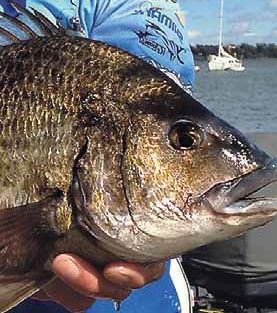 Presented from Issue 101
Presented from Issue 101
What is it about Bream?
While growing up I had the fortune of spending summer holidays at arguably one of the best bream fishing waters in Australia in Ansons Bay. Being young and eager just to feel the weight of a fish on the rod, catching bream was often derailed by chasing the abundant cocky salmon and silver trevally. While these species were on the chew, getting the buzz out of hooking and landing a fish was too much of a temptation. Often schools of bait fish would be busted up in the bay given away by the tell tail signs of seagulls and terns diving in to pick up the scraps left by the salmon as they slammed the abundant anchovies, or what the locals called “sardines”.
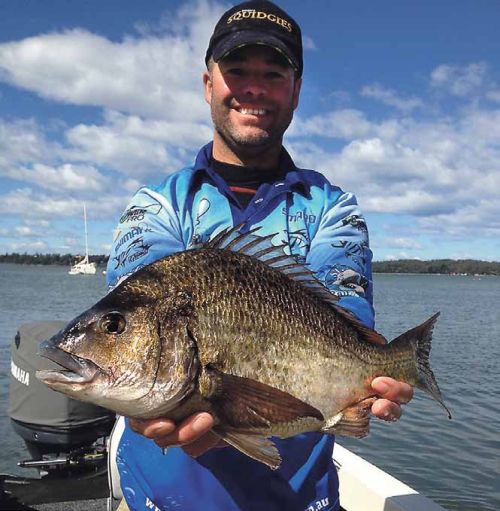 |
| The author with a cracking bream from Ansons Bay. |
My older brother Nigel and I would run from the shack and jump into an old 9 foot marine ply dinghy armed with our spinning rods and silver slice lures, rowing like mad until we were within casting distance of the salmon. Then it was on for all until the school of salmon went quiet as the bait fish dispersed. Out with the oars and lures were out the back and trolled until we found the school of salmon again. A hook up and away we went again. Little wonder the bream were left alone when fishing was this good. Just occasionally while bait fishing, a fish would be hooked which took off like a train and eventually was brought back to the boat with the call, ‘It’s a bream.’ What is it about bream which causes such excitement? Maybe it’s that long run as it hits your bait and peels line off your reel. Or that big golden side as it flashes in the sunlight when you manage to bring it close to the boat….Whatever it is, the bream fishing has had me hooked since those early days.
Plenty of time was also spent up the Ansons River as this is a well known area for catching big bream on bait, if you can get your through the thousands of small ‘pocket watch’ size silver trevally and juvenile bream. Again being young and easily distracted, catching those small trevally on bait was heaps of fun until the bait bucket was empty and not much to show for the efforts. I recall tying on the smallest hooks we had at the time just to teach these little fish a lesson. It was great fun at the time. And it is still a great place to take the kids these days - never a dull moment, baiting hooks and untangling lines.
While all this distraction was great fun at the time, the stories of the big bream which were resident in the bay and how to catch them were often shared by some of the older fishermen. It is these stories I would have to credit (or blame) for my obsession with catching bream. I am not sure whether it was because of the patience and passion these guys had to teach us as young kids how to fish, or the ability to tell the story of how to catch that bream of a lifetime. Of the planning that went into a bream fishing trip. The bait must be fresh, preferably a spotted sand crab, or a fresh locally caught ‘sardine’ The tide must be right at its peak. Just wait for the tide to just start to run out. The cast must be made so the bait sits right on the edge of the weed of a particular deep hole. The bream, if there will pick up the crab and take off like a scalded cat. Make sure that you have some slack line so it does not feel any resistance until the hook is well into the bream’s mouth. Then strike as hard as you can with the old Jarvis Walker Black Queen to set the hook and hang on while a 5lb bream rips line from your Mitchell 301 reel. Well that was the plan anyway. And it did happen to plan on occasion. But, there were also plenty stories of the one that got away. I recall being shown some scales from the side of one bream which was hooked and spat the hook which collected some scales on the way out which were almost as big as 5 cent pieces. This definitely increased the passion and determination of trying to land one of these old and wily monster bream.
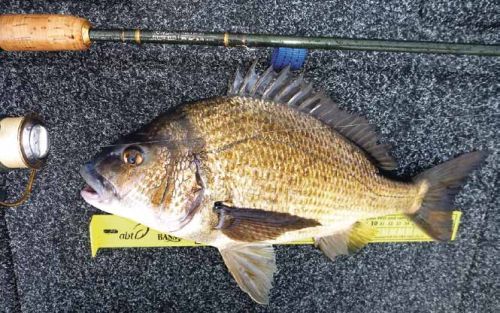 |
| Might need a bigger fish measure soon |
Back in those days the rule of thumb for catching bream was fish a ‘secret spot’ in the bay which was a sand patch surrounded by weed around 2 -3 metres deep. Crabs, prawns, or the ‘sardines’ were used for bait. If there was some current or too much wind, a running sinker with the hook around 300-400mm below this separated using a swivel to prevent the sinker from running down the line and interfering with the bait. If conditions allowed an unweighted hook would do and was generally preferred. Cast out into a sand patch and wait patiently. This is a quite effective way to fish if you find an area where the bream are feeding.
I recall being in the boat with my father and one of his old mates, who had one of these ‘secret spots’ worked out. Lining up a tree up on a hill with a fence post to the west and the shack up on the hill to the north and the big rock — no need for a GPS those days. Get the anchor in the wrong spot and we would do it all again as there was no way we were going to catch anything if we were even a metre away from the right spot. If we went up the river we would always tie up a to a certain tree and cast as far from the bank into the deep water as we could, usually getting snagged on the submerged timber and rocks, only catching the odd good bream every now and then as generally your line was towed back into the meanest barnacle encrusted snag they could find. Try stopping a big bream with the old Black Queen when it wants to go home – mission impossible.
While travelling up the river and crossing the shallower sections we would often see large bream darting away from the boat. Well it didn’t take long for the decision to start fishing these shallow areas was made. Using crabs for bait one evening I recall around 15 bream being caught on a rocky bottom no more than 1 metre deep and thought maybe there is something in this?
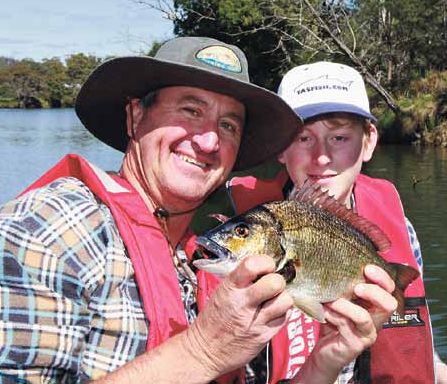 |
| Todd and Jacob Lambert having fun on the Scamander River |
If you fish any of the tidal estuaries on the east coast of Tasmania, you will see that there are usually shallow flats surrounding the bays at around 300-500mm deep before the dropping off into the deeper water. These often consist of open sand with patches of weed offering shelter for bait fish, prawns and shrimps and also plenty of bream looking for a feed.
Fishing the tidal flats can be some of the most exciting bream fishing to be had. The by catch in the shallows can also be bonus as often flathead, whiting or trevally will move into the shallows as the tide rises. Some fishermen may choose to anchor up and throw a bait into a patch of sand and wait, my preference is to actively move across the flats looking for feeding fish casting one of the many types of soft plastic or hard bodied lures available on the market.
These fish are on the flats for one reason only – to eat. So if you can find the bream without them spotting you first, present the right lure and you can normally end up with a bend in your rod. Though some days bream will grab anything you throw at them and other days they will not look at anything you offer. If this happens, keep changing your retrieve or lure until something gets the bream to react and eat your lure. Once you work this out, try and remember what you did and repeat this on the next cast. Bream can be frustrating at times as what worked yesterday may not work today…finding that key which triggers the bite is what makes bream such a challenging fish to catch on lures.
Another thing to observe when fishing for bream, is what kind of terrain you caught the last fish on, Is it muddy, sandy, layered with broken rocks or shellfish? Look for these areas again as your next fish will most likely be feeding on similar terrain. Don’t overlook throwing your lure across the top of weed either. Sometimes the bream will be hiding in this. A good tactic here is to have an each way bet and target sand patches within the weed, throwing a suspending hard body lure just on to the weed and drag it back just into the clear patch of sand, letting it sit for a while, and giving the occasional twitch. If a bream is in either the weed or on the sand and looking for an opportunist feed, it will generally hit the lure as it sits there suspended.
Some of the best flats to fish are the ones which are exposed at low tide, this is not as common at Ansons Bay as there is limited tidal movement, but Georges Bay and the Swan River have plenty of these to look out for. The bream tucker such as crabs and sand worms remain stranded here once the tide goes out. When the tide moves in again the bream also move in and graze on this smorgasboard.
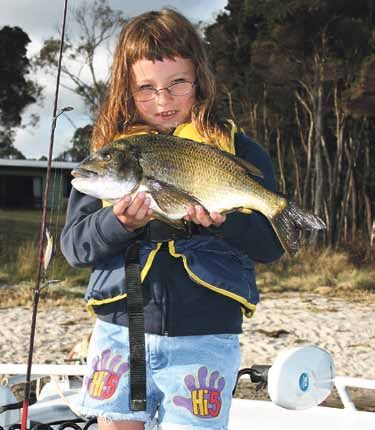 |
| Madeleine Stingel shows her form |
A word of warning though, be very aware of what stage the tide is at if you choose to chase the bream on the flats – miss timing your run back into deeper water could leave you high and dry for quite some time with nothing to cast at but sand – not a bad excuse for being late home from a fishing trip though. Though I would recommend you only use this excuse once.
Once the water starts to flow off the flats a good place to try your luck is on the drop off where the water flows back into the main bay or channel. Here look for any cut out or depression where water is being channelled back into the main flow. Often bream will sit waiting in these pockets for a feed to come to them. Throwing a soft plastic or bait up onto the shallow water and letting it wash into the deeper water will sometimes do the trick.
So when do you fish the flats? Pretty much when there is enough water to float your boat…. The seasons may vary as well with Summer being the best as the water is warm and the food such as prawns are more abundant. Fishing flats remains pretty good until late winter to early spring. Then the bream tend to gather in deeper water with other things, such as reproduction on their mind. If searching flats during winter, using a good depth sounder, check the temperature readout, if the water is just one or two degree warmer than the deeper water, bream can to be drawn to this and can be in the mood to eat. Particularly on a sunny winters day when the sand is dry at low tide so warms up the water on the incoming tide. They are not there all the time but these areas can be very productive on the right day.
One of the big changes with fishing for bream over the years is the gear we now used. This has changed so much since using the old Black Queen and the Mitchell 301. Mind you try and convince some of the older generation anglers out there that there is a better rod on the market — no chance. These days we have high modulus carbon rods with high tech names like ”Nano Series”, which are virtually weightless in your hands and have the power to stop any bream in its tracks. The reels are also light weight and spooled with spider web thin braid or gelspun line, or near invisible fluorocarbon.
The breaking strains have reduced as well. With finesse fishing using lightweight lures, line as low as 2lb breaking strain are now used. The high tech braids or gelspun lines offer no stretch and high strength for diameter giving excellent distance when casting and also super sensitivity so even the smallest bite can be detected.
A leader, preferably using fluorocarbon line, needs to be tied to the end of these lines. Breaking strain and length of the leader will depend on the area you fish. On flats long leaders of 3-4lb are recommended. Personally I like to use just over 2 rod lengths of leader material as this offers a bit of cushioning when a fish hits the lure and also keeps the braid a reasonable distance from the lure so the fish are not spooked as easily. Others prefer to fill their reels with fluorocarbon lines to decrease the chance of spooking fish. On bright sunny days in clear and shallow water these fluorocarbon lines offer a great advantage.
While any style boat or dinghy will do to fish for bream whether with bait or lures, the addition of an electric motor will increase your chances if casting to bream with lures. Especially on flats when searching for fish or holding position in the wind or current or even retrieving your lure from a snag. Some of the modern bow mount electric motors, such as the Minn Kota iPilot, are even equipped with GPS control to hold you in position while you concentrate on trying to catch a fish. A foot control is a must as this enables your hands to be free for important things like casting and retrieving lures.
A common sight these days are high performance boats made from fibreglass and aluminium packed with the latest electronics in fish finders, GPS, fully plumbed live wells etc. These boats will float on water less than 300mm deep so are ideal for fishing flats. They are also designed with low sides so do not catch the wind and blow you too quickly across your fishing spot. These boats are pretty much designed for one purpose — catching bream.
So what is it about bream that makes us dedicate so much time and effort to try and catch them? Tackle shops are full of the lures and rods which are always improving and evolving. Each year something new hits the shelf which is the latest and greatest thing to trick the old wily bream into biting your hook and we all rush out and buy it. Maybe it is because each day when fishing for bream it is never the same as the last time? Just when you think you have everything right, done all your homework on the right bait or lure and the tides and the weather the bream will just not participate in your master plan. And when it does work, these days are golden and keep you coming back for more.
Maybe it is that distinct “Clunk” when a bream hits your lure then that first blistering run as it makes the drag on your reel scream as it charges off to the nearest barnacle covered snag? Whatever it is about bream and, I for one, at every opportunity will be hooking up the boat and heading to an estuary system on the East Coast of Tasmania in pursuit of these wily old bream.
Grant Stingel
